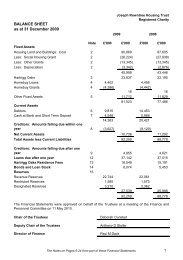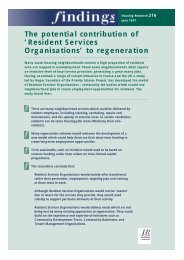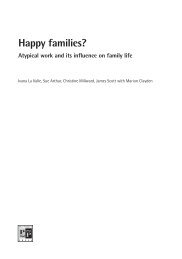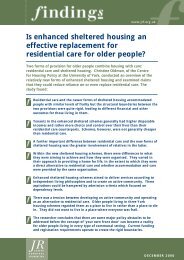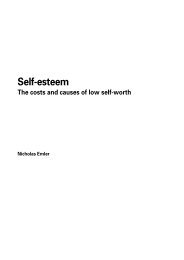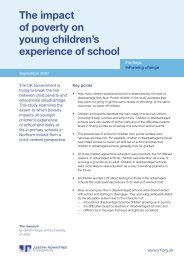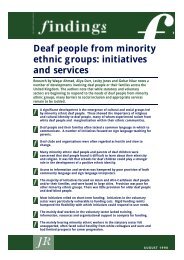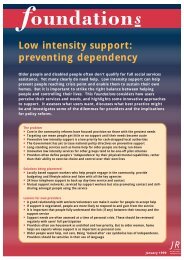Community participation - Joseph Rowntree Foundation
Community participation - Joseph Rowntree Foundation
Community participation - Joseph Rowntree Foundation
You also want an ePaper? Increase the reach of your titles
YUMPU automatically turns print PDFs into web optimized ePapers that Google loves.
Putting the public back into public policy<br />
lives. Rather than expect everyone to participate equally in formal governance, we<br />
should try to make more people’s everyday civic engagement count, by designing<br />
the formal structures of governance in a way that taps into the informal spaces of<br />
community life that they routinely inhabit. By passing information about governance<br />
through non-traditional means (such as the back of gas bills), as well as targeting<br />
people at the stages in their life when they have the most time to give to governance<br />
(such as after retirement), governance is made accountable to a much wider crosssection<br />
of people within the community.<br />
In short, our hypothesis is that the heavy emphasis placed on creating new<br />
structures of community <strong>participation</strong> has come at the expense of a proper<br />
understanding of how their operation is conditioned by the informal cultures that<br />
surround them.<br />
If we want to create social capital through community <strong>participation</strong>, it is not enough<br />
just to create new structures of engagement regardless of whether anyone will<br />
actually bother to use them. We need to pay attention to the relationship between<br />
community <strong>participation</strong> in the formal structures of local governance, and the broader<br />
array of community ties and perceptions that affect the benefits they actually deliver.<br />
And, once we understand this relationship, we can think about how to influence it.<br />
Structure of the report<br />
The next chapter delves into the academic literature to uncover the insights it has to<br />
offer into the links between <strong>participation</strong> in governance and benefits in the form of<br />
social capital for communities. Chapter 3 weaves together the stories of governance<br />
insiders and outsiders in Ely and Benchill. Chapter 4 develops an analysis of the<br />
‘network dynamics’ that produce the patterns we observe in our case studies.<br />
Chapter 5 concludes by looking at the implications of this analysis for policy and<br />
practice, identifying the points of greatest leverage on the problem and making a<br />
number of recommendations for remedying it.<br />
7




